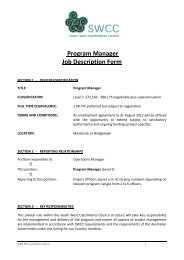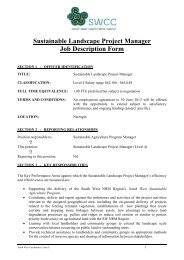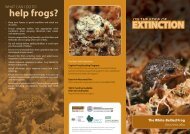Tender for the Programme - South West Catchments Council
Tender for the Programme - South West Catchments Council
Tender for the Programme - South West Catchments Council
You also want an ePaper? Increase the reach of your titles
YUMPU automatically turns print PDFs into web optimized ePapers that Google loves.
DRAFT<br />
<strong>South</strong> <strong>West</strong> Regional NRM Strategy – Ancillary Document<br />
Carnaby’s and Red-tailed Black<br />
Cockatoos; migratory shorebirds;<br />
all native freshwater crayfish and<br />
some native freshwater fish (incl.<br />
pouched lamprey).<br />
TECs (Community types 3c, 7, 8,<br />
9, 18 and 19).<br />
O<strong>the</strong>r ecological communities (7<br />
including <strong>the</strong> White Mangrove).<br />
Various wetlands, including<br />
Leschenault Estuary, Kemerton<br />
wetland chain and billabongs<br />
along Collie River.<br />
Eastern estuary nature reserves.<br />
Dryandra Reserve.<br />
Migratory shorebirds.<br />
Remnant vegetation.<br />
Microbial mats (Lake Preston).<br />
Mt Chudalup<br />
Native fauna<br />
Native flora<br />
Peat swamps<br />
Yeagarup Dunes<br />
Ecosystem Solutions (2009) refined this in<strong>for</strong>mation, assigning priority ranking on <strong>the</strong> basis of 38 criteria in<br />
<strong>the</strong> following five groupings:<br />
Richness (2 criteria);<br />
Rarity (22 criteria);<br />
Distinctiveness (3 criteria);<br />
Representativeness (9 criteria); and<br />
Naturalness (2 criteria).<br />
Eight bio-landscapes were <strong>the</strong>n identified as <strong>the</strong> highest value biodiversity assets in <strong>the</strong> <strong>South</strong> <strong>West</strong> NRM<br />
region that would protect priority fauna and/or flora species/communities, in addition to rare and/or<br />
endangered vegetation associations. A fur<strong>the</strong>r 11 assets of secondary priority were also identified that<br />
contained only priority fauna and/or flora species.<br />
In <strong>the</strong> current strategy, aquatic biodiversity has been separated out from terrestrial biodiversity, as aquatic<br />
fauna and flora have generally been under-represented in past documents and are subject to different<br />
issues and management options. Indeed, aquatic biodiversity assets haven’t been identified as a specific<br />
<strong>the</strong>me area at ei<strong>the</strong>r State, regional or catchment level, but a number of priority assets are listed in various<br />
documents that can be included in this <strong>the</strong>me area. They include:<br />
All “Critically endangered”, “Endangered” and “Estuarine dependent” aquatic species.<br />
Aquatic fauna including all native freshwater fish and crayfish, with priority given to Margaret River<br />
freshwater crayfish, Dunsborough freshwater crayfish, Balston’s Pygmy Perch and <strong>the</strong> lamprey eel.<br />
Very little is known about most aquatic species, so this list will undoubtedly be expanded at various levels<br />
as time goes on.<br />
4.1.2 Previously identified threats to <strong>the</strong> region’s terrestrial biodiversity<br />
The following threats were identified as key threats <strong>for</strong> biodiversity in <strong>the</strong> six IBRA regions represented in<br />
<strong>the</strong> <strong>South</strong> <strong>West</strong> (State NRM Office 2007, Ecosystem Solutions 2009 – high-level threats are shown in<br />
bold):<br />
Climate change;<br />
Dieback (Phytophthora spp);<br />
Decreasing rainfall (drought);<br />
Fire (including inappropriate fire management regimes);<br />
Environmental weeds (Category A) and introduced animals (cats, European fox, rabbits);<br />
Problem species (introduced and native – European Honey Bee, Kookaburra, Minahs, Galahs,<br />
Corellas);<br />
Habitat fragmentation and/or isolation;<br />
41






